The less you mess with Sennheiser’s AVX System, the better.
Review: Preshan John
There’s an endless number of ways to bring a cinema shot alive. And the tools to do it — sliders, stabilisers, jibs, drones and dollies — are now accessible to even amatuer cinematographers. You’ll rarely see a wedding or event videographer without some mechanical contraption clogging up the aisles these days.
Recording incidental sound for film, however, — like dialogue or ambience — is generally more systematic than it is creative. Primarily, it’s got to be present, intelligible, natural and unobtrusive. The creative stuff is mostly left to sound design and post-production.
So when it comes to camera audio, especially run ’n’ gun DSLR video stuff where you’ve donned both cameraman and sound recordist hats, the sound usually serves the vision. It makes the typical requirements for a wireless system — sets up quickly, is easy to use, and performs reliably — even more pertinent.
I reviewed the Audio-Technica System 10 wireless camera mic system review for Video and Filmmaker previously. Even after extensive use, the System 10 continues to be a great example of no-frills yet no-fuss functionality — a valuable trait when your shooting is largely impromptu and without the luxury of much setup time. In a similar, ‘no fuss’ vein, Sennheiser has sprouted the AVX wireless camera mic system.
Unlike the System 10, however, this doesn’t have an ‘entry-level’ vibe about it. With a tag-line of ‘Relax, it’s an AVX’, Sennheiser has added the bells and whistles behind the scenes, so you have to do less fiddling on the field. The specs are all there for a good run ’n’ gun option: 24-bit/48k sampling, 10-hour transmitter battery life, five-hour receiver battery life, AES 256-bit transmission encryption, and lithium ion battery.
The system is offered in three combinations, all of which include the receiver: the Handheld Set, which comes with the AVX-835 handheld upercardioid mic; the Lavalier Set with the AVX-ME2 lapel mic and bodypack transmitter; and the Lavalier Pro Set, which includes the better-quality AVX-MKE2 lapel mic. We were sent the receiver with both the AVX-835 and ME2 mics for review.
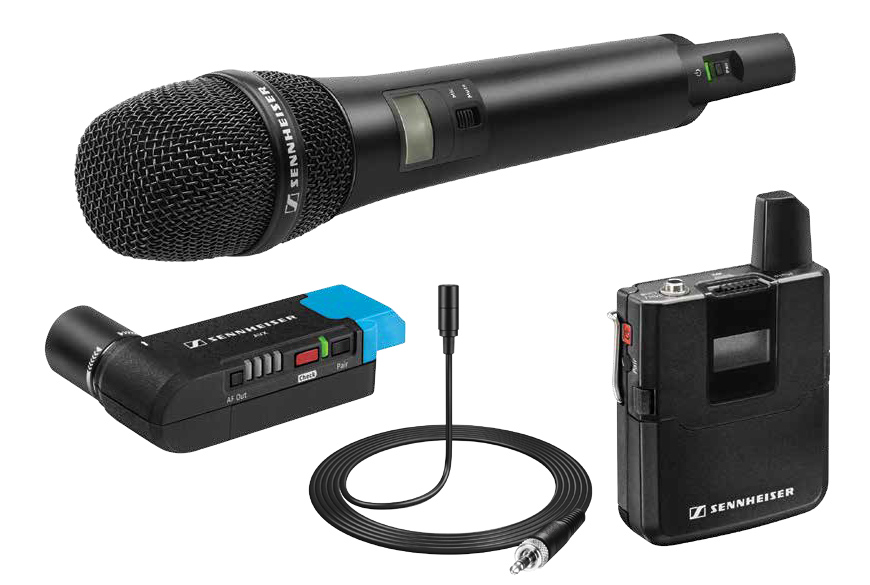
ROADWORTHY
Sennheiser sure hasn’t skimped on build quality. Though they’re diminutive, every piece of kit in the AVX package feels like it could handle being strapped to a warzone journalist’s kit.
The ingenious minuscule receiver is a welcome progression from typical palm-sized on-camera receivers. For camcorder/broadcast-type cameras, it will neatly plug straight into an XLR input — no cables involved. What’s more, turn on your camera’s phantom power and the receiver will automatically switch on and off with it. If you have a DSLR that only accepts audio via jack input, the kit comes with a female XLR to 3.5mm adapter cable.
The receiver can rotate within the hot-shoe mounting clip for flexible camera-top positioning. Alternatively, a belt clip can slot into the hot-shoe on the receiver to wear it on your hip, or clip it to a bag. Sennheiser seems to have thought of everything.
Keep your audio wits about you when filming, and you’ll be pleasantly surprised when AVX helps you out.
Well, almost everything. The one thing I missed on the AVX receiver was a headphone output for monitoring the microphone — something I grew accustomed to when using the System 10. Preferably you want to monitor at the recording end anyway to ensure you’re not clipping, but it does come in handy when using cameras that don’t have their own.
Charging the units only takes a couple of hours, but allow some extra time for the initial power up. All AVX units use a mini USB plug, so you’re never short of ways to get some juice into them. Both the handheld microphone and the belt pack transmitter display pairing status and battery life readouts on their screens. You can check the battery life of the receiver on the four green lights on its side, which illuminate by pressing the power button.
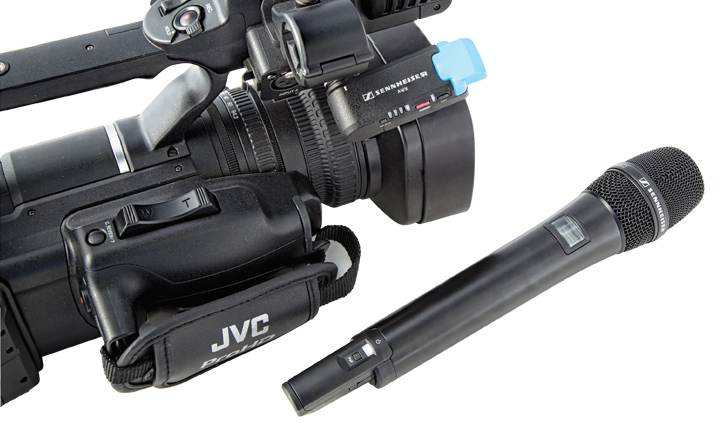
LICENSE TO NIL
The AVX wireless system operates in the license-free 1.9GHz DECT range. Cordless phones are the main devices using the band, so unless you’re standing in the middle of a call centre, finding an interference-free channel is typically hassle free. Up to 12 AVX systems can run simultaneously without stepping on each others toes.
It’s a pretty brainy system according to Sennheiser, with a lot going on under the skin. AVX will dynamically choose unhindered frequencies to operate within while covertly scouting for clear channels. The first sign of interference prompts an inaudible, automatic switch over to another clean channel. There is a 19ms latency penalty for all the dancing around required in this range, but that’s not a big problem if the talent isn’t monitoring their signal.
Transmitting power is up to 250mW and adaptive to distance. It won’t blast out its maximum RF if the receiver’s only a foot away, only what’s required to maintain a secure connection, which in turn conserves power.
Dynamic Range [thanks Sennheiser for co-opting a commonly used phrase – Ed]. The feature is designed to match a camera’s input sensitivity and keep signal levels within an optimum range to prevent clipping or sounds that are too quiet.
Being an audio guy, I’d usually prefer to have total control over levels myself, without any ‘intelligent’ intervention. But when using the AVX, I found Dynamic Range actually resulted in less stress for those time-restricted point-and-shoot moments — and the more I used it, the more it gained my trust.
It’s actually a relief if you’re changing input levels on a DSLR, which typically requires a number of button-presses.
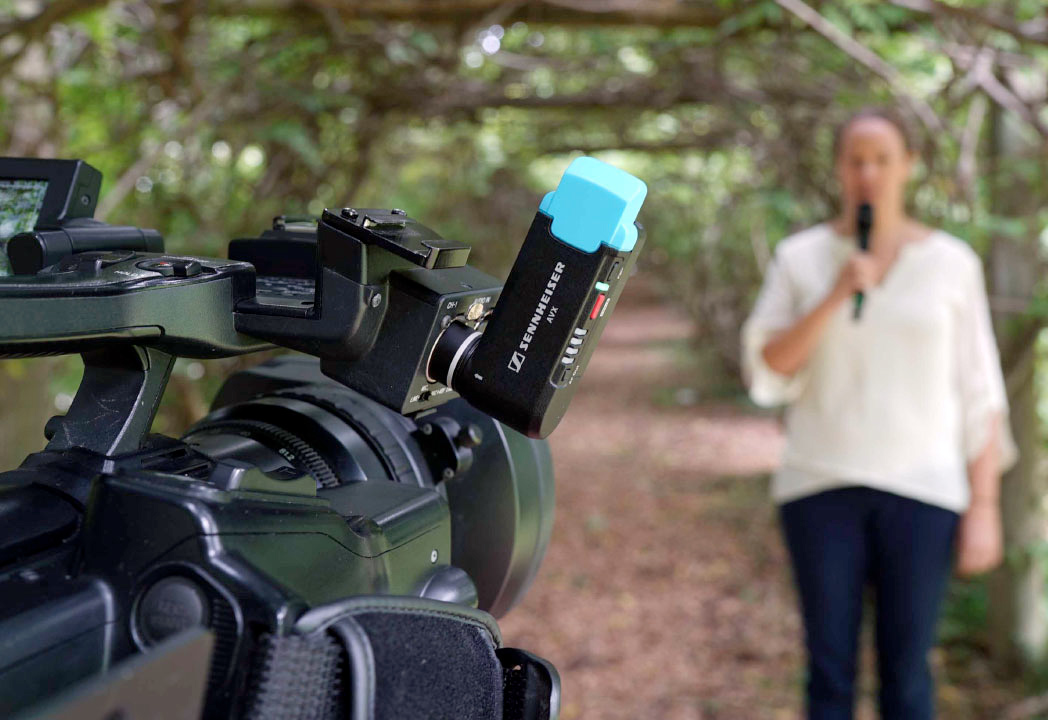
TAKE IT TO THE STREETS
The first time I used the AVX system for video recording was for some informal, outdoor piece-to-camera promo videos — a perfect opportunity to put the two microphones’ intelligibility and wind rejection to the test. Sennheiser’s big promise is that the system should be ready to go in seconds. This was true in my experience. It was simply a matter of pressing the Pair button on both the transmitter and receiver, and waiting for the flashing green light to turn solid. From then on, the receiver automatically paired with either transmitter when powered up.
The specified range of the AVX system is 30m for regular interview-type shooting. In my tests it managed close to 50m line-of-sight, but it dropped out the moment I turned a corner. Perhaps not the system for those Getaway ‘where is the presenter? Oh, there she is, on the boat’ long zoom-ins.
The handheld mic performed very well, although it was slightly prone to plosives. It sounds fantastic though, delivering polished, natural speech reproduction and an extended high end. The super cardioid capsule has good off-axis rejection, so it’s comfortable in relatively noisy environments provided you keep it close to the sound source — which is just as well because I thought its proximity effect was rather pleasing on spoken word. The red/green status indicator light doubles as the On/Off switch, and its position makes accidental power cycles a near impossibility.
Dynamic Range, the auto level control feature, did a great job with the AVX-835 mic. I gained up my mic input about a third of the way, paired the handheld mic with the receiver and let AVX do the rest. It managed ordinary fluctuations in SPL with commendable finesse — not once did the camera’s input clip or drop off to an unusably low level.
I should add that changes in level aren’t always drastic. Don’t expect results holding the mic six feet from the talent’s mouth in the hope it’ll sufficiently crank up the gain. In other words, keep your audio wits about you when filming, and you’ll be pleasantly surprised when AVX helps you out.
It was a slightly different story with the MKE2 lapel mic. The AVX system’s automatic level feature wasn’t as nimble with the lapel mic’s input.
Sonically, the ME2 capsule sounded pretty good — a little ‘congested’ when compared with the airiness of the handheld, but that’s to be expected with any body-worn mic. It pays not to clip the mic right up under the talent’s neck, or you’ll end up with more honk than an angry truck driver — I found clipping it about 15cm down from the collar provided natural-sounding results. If you’ve got someone bellowing into the lapel, you can reduce the output further by pressing the AF Out button on the receiver, which attenuates the signal by four 10dB increments.
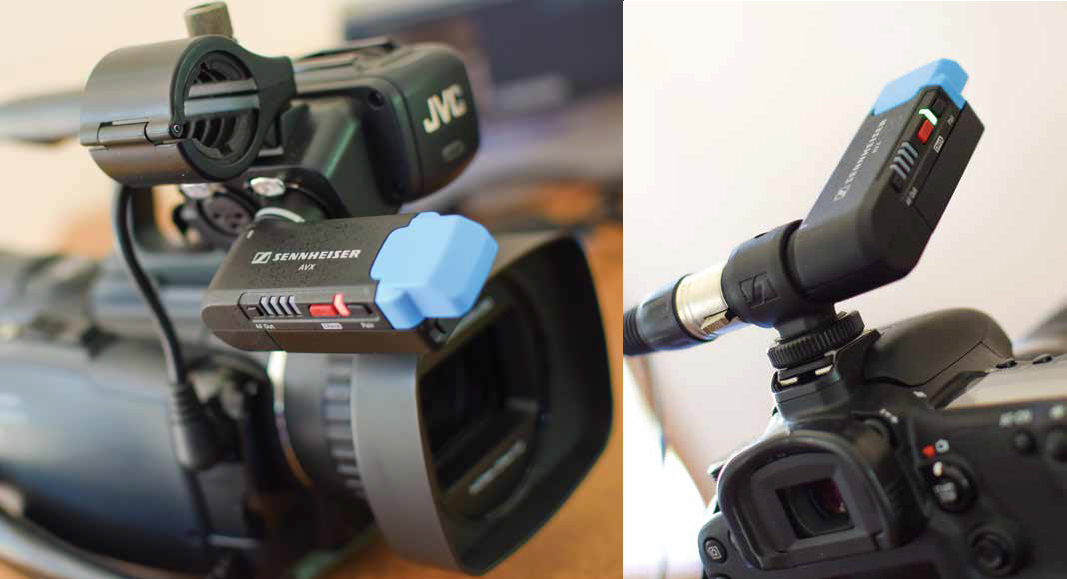
FOLLOW THROUGH
The AVX system proved to be very reliable over multiple uses, with all units demonstrating an impressive battery life. I gravitated toward the AVX-835 handheld mic for most applications because it had that slight edge in sound quality. It worked best for solo presenters. Catching interview dialogue can be a bit harder with the tight pattern, and for anything else, there’s not much chance keeping the big black mic out of frame.
It’s not to say the ME2 was a poor performer — it still sounds great on spoken word and is far less conspicuous than the AVX-835. The ME2 was better suited to a calm and collected approach, where you have the time to carefully position it, check levels, and ask the talent to run the cable down their shirt. And remember you can buy an AVX set with the better quality MKE2 capsule if lapel mics are your thing.
Sennheiser’s AVX system does what it says it will. More importantly, there’s a payoff to all those behind the scenes features; a distraction and inconvenience-free experience while you’re trying to nail that perfect shot. In my experience, it really was the closest to a set-and-forget system I’ve used. If you’re willing to pay a little extra for a little less hassle, then the AVX system might just be the perfect fit for you.
NEED TO KNOW
PRICE:
- Handheld Set: $1499
- Lavalier Set: $1499
- Lavalier Pro Set: $1749
CONTACT:
Sennheiser Australia – (02) 9910 6700 or sales@sennheiser.com.au
PROS:
- Quick auto setup & pairing
- Tiny, but well-made & designed
- Auto gain-riding works well
- Good sound quality
CONS:
- Headphone output on receiver would be nice
SUMMARY:
The Sennheiser AVX wireless system is easy to use, built extremely well, performs reliably and doesn’t get in the way of your creative flow. Sound quality is impressive, especially from the handheld AVX-835 microphone. It’s not the cheapest camera audio accessory, but if you want to evade audio distractions while filming, the AVX should rate high on your list.


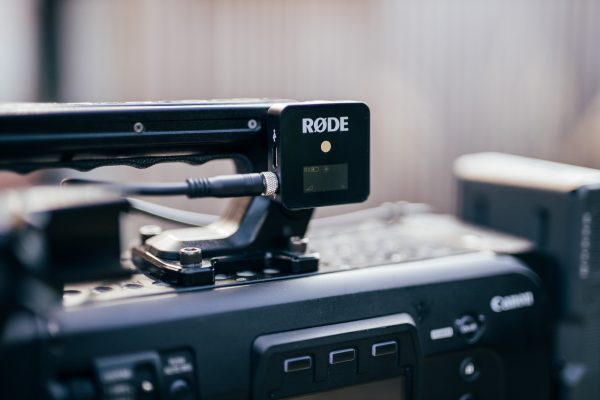


Niall Mulligan
Very interested in this from a wedding perspective. Question though, if in very close proximity to a former radio microphone, will you get cell phone like interference?
Video & Filmmaker
Preshan (the reviewer) mentions in the article that the system operates in the license-free 1.9GHz DECT which is largely interference-free. However, cordless standard phones (not cell phones) may cause interference, but at the first sign of interference the AVX automatically switches to a clean channel.